#the temple of Vespasian and Titus
Text
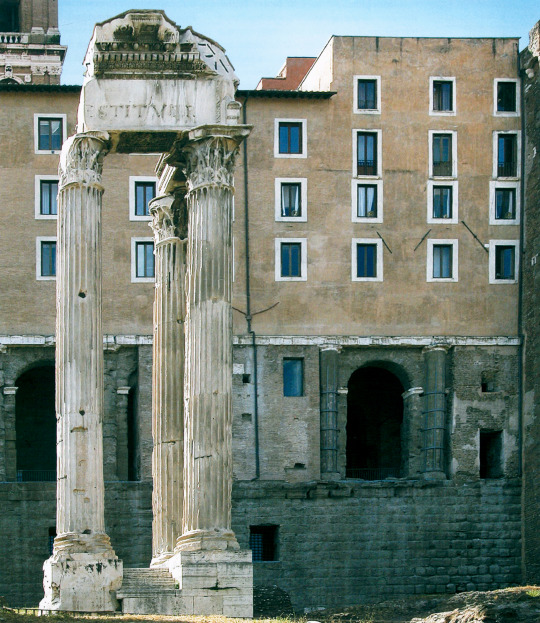
The Temple of Vespasian and Titus, Roman Forum, Rome, Italy
193 notes
·
View notes
Text
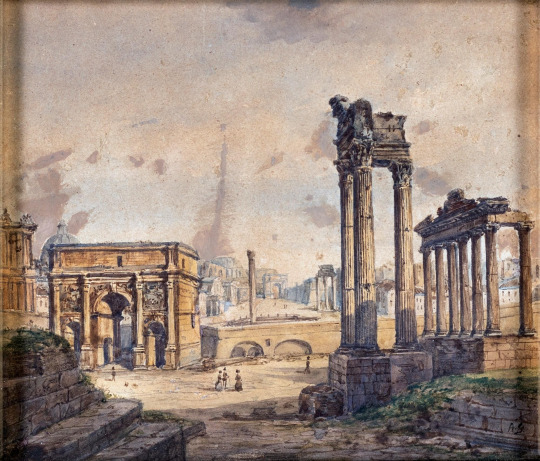
View of the Roman Forum with the Arch of Septimius Severus, and the remains of the Temple of Vespasian and Titus, and the Temple of Saturn.
by Arthur John Strutt
#arthur john strutt#art#ruins#architecture#rome#ancient rome#roman#antiquity#italy#landscape#city#roman forum#arch#septimius severus#temple#temples#columns#vespasian#titus#saturn#europe#european#romantic#romanticism#monument#monuments#history#cityscape
84 notes
·
View notes
Photo

Temple of Vespasian and Titus in the Roman Forum
Rome, Italy
#Temple of Vespasian and Titus#roman forum#forum romanum#rome#italy#europe#travel#travelling#architecutre#ancient#ancient rome#ancient roman#temple#my photos
49 notes
·
View notes
Text
Did the Vatican steal the ancient Menorah?
The Vatican stole the Menorah of Moses and hid it in the basement of St Peter's. This conspiracy theory refuses to die! And the Vatican is partly to blame..
One of the strangest conspiracy theories circulating today is that the Vatican is in possession of the ancient Menorah fashioned by the prophet Moses at the direct command of God. This is the seven-branched candelabrum that the Israelites carried with them during the Exodus from Egypt and later installed in the Temple of Solomon in Jerusalem. Like all the temple treasures, including the Ark of…

View On WordPress
#Arch of Titus#Ark of the Covenant#Babylon#death#history#Israeli Antiquities Authority#John the Deacon#Knights Templar#medieval#Menorah#Rome menorah#Saint John Lateran#Temple of Solomon#Titus#Vatican menorah#Vespasian
0 notes
Text
Did the Vatican steal the ancient Menorah?
The Vatican stole the Menorah of Moses and hid it in the basement of St Peter's. This conspiracy theory refuses to die! And the Vatican is partly to blame..
One of the strangest conspiracy theories circulating today is that the Vatican is in possession of the ancient Menorah fashioned by the prophet Moses at the direct command of God. This is the seven-branched candelabrum that the Israelites carried with them during the Exodus from Egypt and later installed in the Temple of Solomon in Jerusalem. Like all the temple treasures, including the Ark of…

View On WordPress
#Arch of Titus#Ark of the Covenant#Babylon#death#history#Israeli Antiquities Authority#John the Deacon#Knights Templar#medieval#Menorah#Rome menorah#Saint John Lateran#Temple of Solomon#Titus#Vatican menorah#Vespasian
0 notes
Photo

History Events on July 20
0 notes
Text

A Tale of Two Coins - 2000 years apart!
On the right is a Judea Capta coin from 71 AD, 1952 years ago. The coin says “Judea conquered" in latin. These were commemorative coins originally issued by the Roman Emperor Vespasian to commemorate the capture of Judea and the destruction of the Jewish Second Temple by his son Titus in 70 CE during the First Jewish Revolt. On one side of the palm tree is a weeping defeated Jewish woman. On the other a victorious Roman soldier.
On the left, we see the same palm tree representing the Jewish homeland, but instead of a Roman soldier, there is a Jewish woman holding a baby up to the heavens symbolizing the rebirth of the Jewish people like a phoenix out of the ashes. In place of the weeping woman is a Jewish farmer (her husband) planting new roots for the Jewish people in the Jewish homeland. Instead of “Judea Capta'' the words read - “Israel Liberated 1948″.
These two coins sum up the history of exile and return of the indigenous Jews to the Kingdom of Israel.
In the prophetic words of the Bible: “They who sow in tears shall reap in joy.” (Psalm 126)
#secular-jew#israel#jewish#judaism#israeli#jerusalem#diaspora#secular jew#secularjew#islam#coins#ancient coins#judean coinage#judea#samaria#romans#judea capta#vespasian#titus#emperor#roman empire#Israel liberated#1948#hamas#coinage#second temple#1st century#palestine#Palestinian#gaza
366 notes
·
View notes
Text
Titus Flavius and his indelible traces.
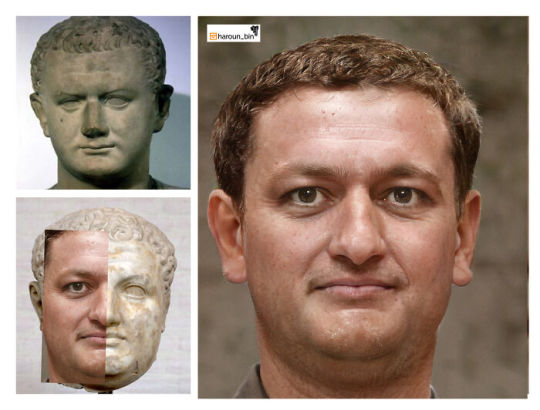

Titus Flavius was born in Rome on December 30 of the year 39. His great-grandfather had been one of Pompey Magnus's loyal soldiers during the Civil War against Julius Caesar. He escaped capture after Pompey's defeat at the Battle of Pharsalia. Years later he became a publicanus (tax collector). In an incredible twist of fate, the Flavians, a family of peasants, who came from the defeat of the past, ended up occupying the throne founded by Caesar's heir, and replacing the aristocratic Julio-Claudian dynasty with the Flavian dynasty.
During reing of Caligula (37-41) Vespasian,father of Titus, was Aedile of Rome. According Suetonius, Emperor Caligula passed by a street that was very dirty, ordered Vespasian to be brought and the garbage thrown on him, and then told him "Do your job well, keep the city clean."
During the reign of Claudius (41-54) Vespasian obtained the position of praetor and the command of one of the legions that went to the conquest of Britannia.
After revolt in Judea in the year 66, emperor Nero chose the experienced and brilliant general Vespasian to put an end to the rebellion. Vespasian went with his son, Titus, who was then 26 years old, and was an excellent army's officer.
Nero, the last of the Julio-Claudian dynasty, committed suicide in 68, which generated a civil war. On December of the chaotic year 69, known as the year of the 4 emperors, in which three aristocrats came to the throne and were murdered, Vespasian was proclaimed emperor by the army. Titus was left in command against the rebellion in Judea.
A historical event of mystical relevance.
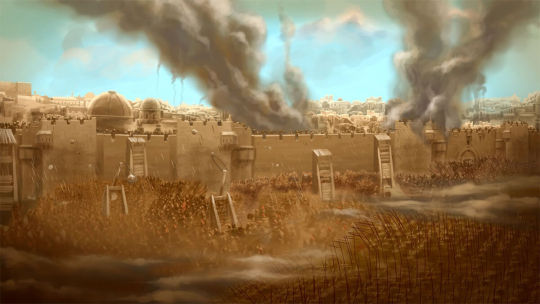
After months of bloody fighting, on August of the year 70, the Temple of Jerusalem was looted, burned and demolished by Titus's troops. This ended the rebellion in Judea.
Titus made his triumphal parade in the year 71 in Rome. Years later, in the place where Titus passed, his younger brother, the Emperor Domitian, ordered the construction of the Arch of Titus; One of its extraordinary relief depicts the triumphal parade with the treasures of the Temple.

Emperor Vespasian decided to tear down the Domus Aurea, the palace that Nero had ordered to be built for his own enjoyment, and build "a palace for the enjoyment of the people". He saw his work almost completed but died of illness on June 23, 79, at his estate. The next day Titus ascends the throne.
A mess with the gods.
Exactly 4 months after his accession to the throne and while his younger brother was celebrating his birthday, a tragic event occurred. An inexplicable and terrifying news reached Rome: the peaceful mount Vesuvius roared, exploded and became something unknown, and several Roman cities with their inhabitants disappeared under "a sea of fire." Among the victims was the prestigious politician, soldier and writer Pliny the Elder, a close friend of the imperial family, who had dedicated the book he was still writing (Naturalis historia) to Titus.

Emperor immediately went to the scene of the disaster. He made immense works and donations to help those affected in the area. Early year 80 he went there for the second time and at that time a fire broke out in Rome for three days. Rumors began to circulate that the emperor had a "problem with the gods", and it was due to his loving and forbidden relationship with the Hebrew princess Berenice.
Although he was a very popular emperor, he did not want to risk those tragedies affecting his image and the people becoming angry, so he decided in 80 to accelerate his father's work, which still had to wait to be completed. And so began the inauguration of the most famous "stadium" in history : The Flavius amphitheater, better known as The Colosseum.
There were 100 days of shows and games. Those shows were free for the people. They had never seen an amphitheater of such grandeur. Very soon the people of Rome forgot about Vesuvius and Berenice.

Coins were minted showing the work started by his father but completed and inaugurated by him. In the image: a sesterce from the time of Emperor Titus.

The pseudo-Nero.
After Nero's death, for many years rumors circulated throughout the empire, and even beyond its borders, that Nero was actually alive, hidden somewhere.
Suetonius wrote about an event that he experienced during the reign of Domitian: << Twenty years after his death, during my adolescence, a man who boasted of being Nero having appeared, found such a favorable reception among the Parthians that energetically supported, it was handed over to us with difficulty.>>
During his reign Titus had to face the rebellion of a guy called Terence Maximus, a Pseudo-Nero that according to ancient historical sources "he sang with a voice equal to that of Nero, played the lyre and looked like him." The impostor had a lot of followers in the eastern Roman provinces. The Parthian king, Titus's enemy, received this man and made preparations for him to return to Rome as emperor but he was executed when his true identity was revealed.

On September 13, 81, Titus died at the age of 41 on his father's farm, due to fever. His brief reign was very prosperous and popular.
Having only a daughter (Julia Flavia), his successor was his brother Domitian who would rule for 15 years.
The Colosseum and the Wailing Wall are undoubtedly the two indelible traces of Titus Flavius.
145 notes
·
View notes
Text
Free!
"Leave our country alone!"
they say
"This isn't your land -
go back to where you came from!"
And as my brother's being shoot,
And my sister's being paraded naked -
For their great sin of: living
[Re'im, Israel, 2023]
As my great-grandfather was pushed down in the streets
And his beard was brutally shaved
As they raped and enslaved and murdered-
[Birkenau, Poland, 1943]
[just like in 1941 Farhud, Iraq ; Jedwabne pogrom; 1945 Tripoli pogrom, the 1946 Kielce pogrom, and the 1947 Aleppo pogrom]
In 1934 there were pogroms against Jews in Turkey and Algeria.
Other parts of my family were lucky enough to survive the 1929 Hebron massacre during the 1929 Palestine riots.
[Mandatory Palestine under British administration]
In 1919, soldiers marched into the center of town accompanied by a military band and engaged in atrocities under the slogan: "Kill the Jews, and save the Ukraine." They were ordered to save the ammunition in the process and use only lances and bayonets during the Proskurov pogrom.
[Proskurov, Ukraine, 1919]
[100 years, and nothing changed, huh?]
You know, my grandma's arab. I still remember sitting in class in high school, hearing about the 1840 Damascus affair, and thinking:
hu.
I'll skip several years and countries, but:
Their grandparents were there to witness as the outbreak of violence against Jews (Hep-Hep riots) occurred at the beginning of the 19th century.
The 1821 Odessa pogroms marked the beginning of the 19th century pogroms in Tsarist Russia
That's Khmelnytsky Uprising of 1648–1657 in present-day Ukraine.
So they said, during the attacks against Jews also took place in Barcelona and other Catalan cities during the massacre of 1391.
Their ancestors were cast away and murdered in Spain, 1492.
The same way we were banished and cast away from Bern (1427) and Zürich (1436) for almost 400 years?
Let us not speak of the alaughter on Holy Saturday of 1389, a pogrom began in Prague that led to the burning of the Jewish quarter, the killing of many Jews, and the suicide of many Jews trapped in the main synagogue; the number of dead was estimated at 400–500 men, women, and children.
Brussels massacre of 1370.
Or - do you want to hear about the 510 jewish communities that were destroyed? (1348-1350)
including in Toulon, Erfurt, Basel, Aragon, Flanders[16][17] and Strasbourg.[18]
Just like Rhineland massacres in 1096
Some of them made it to England, around 1060.
It took less than 30 years for the first Podrom in 1189-90 in England,
Oh, and let us not forget 1066 Granada massacre [again, in Spain].
Or the Alexandria in the year 38 CE, followed by the more known riot of 66 CE.
The Jewish population of the land on the eve of the first major Jewish rebellion [66 CE] may have been as high as 2.2 million. The monumental architecture of this period indicates a high level of prosperity.
In 66 CE, the Jews of Judea rose in revolt against Rome, sparking the First Jewish–Roman War. The reverse seized control of Judea and named their new kingdom "Israel"
The revolt was crushed by the Roman emperors Vespasian and Titus. The Romans destroyed much of the Temple in Jerusalem and took as punitive tribute the Menorah and other Temple artifacts back to Rome. Josephus writes that 1,100,000 Jews perished during the revolt, while a further 97,000 were taken captive. The Fiscus Judaicus was instituted by the Empire as part of reparations.
[And here we come to a full cycle of blood, land, and pain].
And those are only those I found out about. Only those we have a record of. Only those we know to this day. They were so massive, or left enough impact so we still remember.
[I could go on, this is just a short list.]
It seems like no matter what we do, we'll always be accused for
Let me know, please - where can I be a jew, and just
Live?
#israel#jews#jewish history#history#palestine#Juda kingdom#pogrom#pogroms#terror#manslaughter#massacre
135 notes
·
View notes
Photo

The Roman Empire during the Flavian Dynasty, 69 - 96 CE
A map illustrating the territorial extent and political boundaries of the Roman Empire during the Flavian Dynasty, around 96 CE. Although a short-lived sequence of reigns from Vespasian (69 - 79 CE) through Titus (79 – 81 CE), until Domitian (81 - 96 CE), the Flavians (an Italian gentry, and not traditional Roman aristocracy) are remembered for restoring stability to Rome after the turbulent reign of the last Julio-Claudian – Nero, and the civil wars that had wreaked havoc on the Empire and Italy in particular. Theirs was a rule noteworthy for increased recruitment of equites (upper-class plebeians) to the imperial administration and civil service, the destruction of Jerusalem and the Temple, the eruption of Mount Vesuvius, the completion of Amphitheatrum Flavium (better known as the Colosseum for being in the vicinity of a giant 30 meters (98 feet) bronze statue called the Colossus of Nero) and signing an uneasy peace treaty with the Dacians before the conflict flared up again under the reign of emperor Trajan.
Image by Simeon Netchev
91 notes
·
View notes
Text
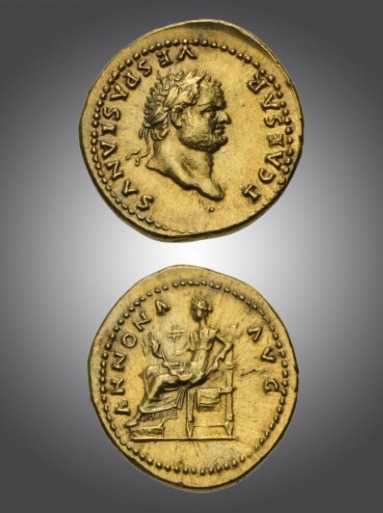
Roman Coin - Gold Aureus of Titus
AD 78-79
Portrait of Titus T CAESAR – VESPASIANVS. Reverse: ANNONA AVG. Annona seated holding bundle and corn ears in both hands.
Titus Caesar Vespasianus (30 December 39 – 13 September 81 AD) was Roman emperor from 79 to 81. A member of the Flavian dynasty, Titus succeeded his father Vespasian upon his death.
Before becoming emperor, Titus gained renown as a military commander, serving under his father in Judea during the First Jewish–Roman War. The campaign came to a brief halt with the death of emperor Nero in 68, launching Vespasian's bid for the imperial power during the Year of the Four Emperors. When Vespasian was declared Emperor on 1 July 69, Titus was left in charge of ending the Jewish rebellion. In 70, he besieged and captured Jerusalem, and destroyed the city and the Second Temple. For this achievement Titus was awarded a triumph; the Arch of Titus commemorates his victory to this day and age.
During his father's rule, Titus gained notoriety in Rome serving as prefect of the Praetorian Guard, and for carrying on a controversial relationship with the Jewish queen Berenice. Despite concerns over his character, Titus ruled to great acclaim following the death of Vespasian in 79, and was considered a good emperor by Suetonius and other contemporary historians.
As emperor, Titus is best known for completing the Colosseum and for his generosity in relieving the suffering caused by two disasters, the eruption of Mount Vesuvius in AD 79 and a fire in Rome in 80. After barely two years in office, Titus died of a fever on 13 September 81. He was deified by the Roman Senate and succeeded by his younger brother Domitian.
#Emperor Titus#Titus Caesar Vespasianus#Roman Coin - Gold Aureus of Titus#AD 78-79#coins#collectable coins#roman coins#gold#gold coins#ancient artifacts#archeology#archeolgst#history#history news#ancient history#ancient culture#ancient civilizations#ancient rome#roman history#roman empire#roman emperor
49 notes
·
View notes
Note
Hello! I have a humble ask for you if you have a bit of time to indulge me. While I understand from your name that your interest is primarily in the late republic, I was wondering if you had any recommendations for me regarding a slightly later period:
I’ll be taking a class on the Roman Empire and its emperors (+Julius probably) next semester. I’ve got more of a background in Classical Greek history than Roman, so I’m a bit out of my depth. I did a brief survey of some of the early big names in high school (mostly I just remember J Seas, October August, Capri Pants Tibby, Little Booties, Neckbeard Zero, and Ostrich Boy, though I’m sure we covered others), but I was wondering if you had any recommendations for interesting figures in and around the imperial court at really any time during the centuries of Roman Empire to look out for and/or stan in the coming year. I tend to find that being able to latch on to interesting people with lots of personality or story about them makes it easier to study the surrounding events, so I’m hoping for some help from fellow tumblr nerds to get a head start on that. Thank you for reading (and perhaps replying)!
Welcome, dear reader! It sounds like you're in the market for a blorbo...or perhaps a punching bag!
You already know the Julio-Claudian Clusterfuck, so I'll skip them. (I recommend all of them though!) If you enjoyed their family drama, you'll find even more of it in the Severan dynasty. Starting with Rome's first African-born emperor, through his fratricidal sons, to Elagabalus - who might've been what we now call transgender, but it's hard to tell. These folks make the Julio-Claudians look stable.
Or maybe you'd prefer a more relatable guy like Marcus Aurelius. He's one of the few emperors whose inner personality we can really see, thanks to his diary surviving and getting renamed the Meditations. I think many people struggling with depression, anxiety or existential dread might find a lot in common with Marcus' writings. He was a good guy who tried his best, despite never wanting to be emperor and facing horrible luck. His predecessor Antoninus Pius was also a very cool dude, the kind who did good quietly and resolved issues with diplomacy instead of war. They're two of the few emperors I think were actually good people.
If military history's your thing, you can't go wrong with Trajan, Aurelian or Constantine. Trajan conquered Dacia and Mesopotamia, making the empire bigger than ever. Aurelian's superb leadership and character helped to end a 40-year civil war. People seem to either love Constantine or hate him. He was also the first Christian emperor, and played a huge role in shaping Christianity as an institution and orthodox set of beliefs. Whether that was good for Christianity is a question in itself...Constantine's family had tons of drama, too!
If you'd rather pray to Jupiter than Jesus, you'll probably like Julian, Rome's last pagan emperor and a Huge Fucking Nerd. He's a favorite of alternate history buffs for what paganism and Christianity might've turned into if he lived longer. Also, he wrote satirical fanfiction about other emperors for fun!
Vespasian, Titus and Hadrian are interesting if you're into Jewish history. Well, "interesting" in a bad way...You can blame the first two for the destruction of the Second Temple, and Hadrian for the atrocities of the Bar Kokhba revolt. I liked reading Flavius Josephus' account of the first Jewish revolt, which characterizes Vespasian, Titus and Herod (that Herod) quite vividly. It's a very bloody tragedy, and all the trigger warnings apply, but it really brings this time period to life. (Get an edition with a Jewish translator, if possible - older Christian-led translations tend to shove antisemitic junk in there.)
Titus was the emperor when Mt. Vesuvius erupted, so the ruins of Pompeii and Pliny the Elder's wacky Natural History date to Titus' time. Some people really connect with Hadrian's famous gay love affair with Antinous, and he was an incredibly well-traveled man who left monuments like Hadrian's Wall all over the empire...but his genocide in Judea overshadows everything else for me.
But hey, maybe you're fascinated by the awful ones. Or maybe you think some emperors have been misunderstood. There's been a lot of discussion in recent years over whether Tiberius, Nero, Domitian and Commodus were as bad as they're usually portrayed. I'm only really acquainted with Tiberius. In his case, I found not a monster, just a deeply troubled man who'd been put into the worst job possible against his will.
I don't know many imperial women, but I gotta give shout-outs to Livia, Julia the Elder, Agrippina the Elder and Younger, Empress Theodora (wife of Justinian), and Empress Irene (whom Charlemagne wanted to marry!).
Readers, feel free to chime in with your favorite emperors, empresses and court-adjacent Romans! The wilder the stories, the better!
#just roman asks#local-queer-classicist#roman emperors#suetonius is also a lot of fun for reading about the first twelve emperors#even if he's blatantly wrong sometimes. especially when he's wrong#A+ source of imperial gossip#genocide mention#jlrrt essays
14 notes
·
View notes
Note
So re your tags on the pope post...
Where's the menorah krindor?
So, starting at the very beginning.
70 CE: Titus sacks Jerusalem and loots the Second Temple. In his triumph (fancy war parade) he has the Menorah, as is recorded by Josephus Flavius in 71 CE and by the Arch of Titus' reliefs in 81 CE
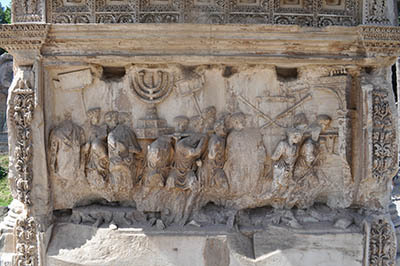
The Menorah is displayed in the Tempulum Pacis in Rome, and 2nd century CE Rabbis claim to have seen it in Rome, as well as various other artifacts from the desroyed temple including the parochet and the choshen.
Now here's the thing. This is the last time historical texts mention the Menorah by name so everything below here needs to be taken with an increasing pile of salt
410 CE: The Visigoths sack Rome. Procipius of Ceasarea (500-560), a Byzantine Historian, writes that the Visigoths take "treasures of Solomon the King of the Hebrews." If this includes the Menorah, the trail goes cold. So that's it right? The Menorah got taken to a secondary location and was lost forever, right?
Wrong, because that's not the only time Procipius mentions Jewish Temple loot.
425 CE: The Vandals sack Rome again, to the point where the word vandalize comes from it. Procipius notes that their leader, Geiseric, takes "a huge amount of imperial treasure" with him to Carthage, which was at that time the Vandal capital.
Trust me this is relevant
534 CE: The Byzantine Emperor Justinian sacks Carthage, and they hold a triumph in Constantinople. Among the paraded items are "treasures of the Jews, which Titus, the son of Vespasian, together with certain others, had brought to Rome after the capture of Jerusalem”
That these "treasures of the Jews" include the Menorah is not a new theory, as is indicated in the 19th century painting Geiseric sacking Rome by Karl Bryullov

(Note the Menorah)
So it's in Istanbul right?
Wrong, because our boy Procipius isn't done yet: according to him, Justinian sent the "treasures of the Jews" to Christian sanctuaries in Jerusalem, since he heard that they were cursed that any city save Jerusalem that held them was doomed to be sacked.
This is the last time the "treasures of the Jews" are mentioned in historical texts.
So for our next step, lets look at major churches in Jerusalem in the 6th century, and officially enter the cork-board and string section of this rant post.
As well as the extant Church of the Holy Sepulcher, the Hagia Sion Basilica, and the Church of the Holy Apostles, Justinian built a church himself in the city, called the Nea, in 534 CE, just nine years after sacking Carthage. It would not be unreasonable that he'd send the Menorah to his own church, so we can theorize that it's in the Nea for the remainder of the 6th century (there are, of course, problems with relying on one historian's account of these things, but this is for fun, not a published article)
So that's it? It's in one of the churches of Jerusalem?
...
So in 614 CE Jerusalem gets sacked by the Sasanian/Persian Empire, who according to historical records destroy all the churches.
Now here's the thing. Recent archaeological evidence gives rise to the possibility that our Byzantine historical sources are trying to stir up outrage against the Sasanians: While mass graves dating to around 614 CE were found, the churches and Christian residential neighborhoods were barely, if at all, damaged, and the Nea itself was very possibly completely undamaged. This is, however, a recent theory, and the academics are still hashing it out.
So it may be in one of the churches of Jerusalem?
Tragically, even if the 614 siege didn't get the churches, in 1009 the Fatimid Caliph al-Hakim bi-Amr Allah destroyed all churches, synagogues, and many religious artifacts of both Christians and Jews in Jerusalem. So if by some miracle the Menorah had survived until this point, if it was in Jerusalem it was most likely destroyed.
But that's disappointing, and what's a good conspiracy theory without going a step or two beyond what is reasonable?
Apparently, while the churches, synagogues and most of the artifacts were destroyed, at least in the case of the Church of the Holy Sepulcher, objects that could be carried away were looted, rather than destroyed. And if we know anything about the Menorah at this point, that thing is certainly able to be carried away by people.
If the Menorah was looted rather than destroyed, it's not unreasonable that it would have made it's way to the Fatimid capital of Cairo. However, as the historical record dried up some 500 years beforehand, beyond this point it's unreasonable to attempt to track the Menorah.
So that's it. If the Menorah wasn't destroyed it most likely made its way to Egypt and was lost or destroyed there.
Is what I'd say if I wasn't so far down this rabbit hole I was beyond reason. Because as we all know there's one place that has all the significant treasures of Cairo and a penchant for looting:
The British Museum
#i cant in good conscience call this either archaeology or history#anyway this is very unhinged but was fun to research#pseudoarchaeology#pseudohistory#jewish stuff
13 notes
·
View notes
Text
Coins of the 12 Caesars: Vespasian
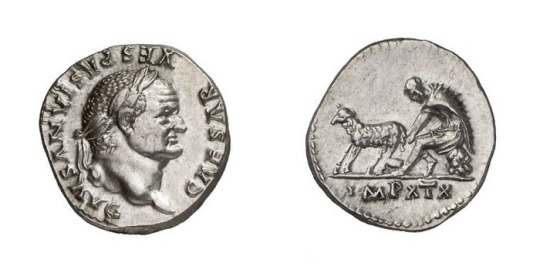
Vespasian denarius, struck 77-78.
Obverse depicts Vespasian facing right.
Reverse depicts a strange goat milking scene, nobody seems to know why this design was used.

Vespasian aureus, Struck at Tarraco in either late 69 or early 70.
Obverse features one of the earliest portraits of Vespasian on coins.
Reverse depicts walking right, holding a spear and a trophy. Legend reads "MARS VLTOR" or "Mars the Avenger". According to the NAC lot description this coin was probably struck after the battle of Cremona in October 69.
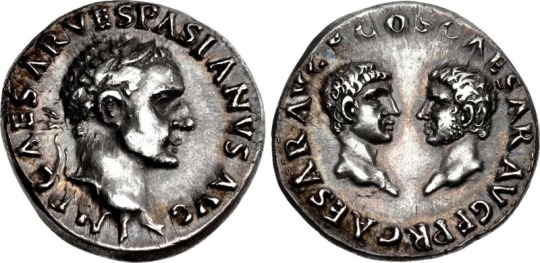
Vespaisan denarius, struck 70.
Obverse depicts a distinctly early portrait of Vespasian.
Reverse depicts his two sons, Domitian on the left and Titus on the right. This dynastic issue is meant to serve as a reminder to the Roman people that the Flavian dynasty was secure with two successors. The empire had just clawed its way out of a brutal civil war and needed a stability.

Vespasian denarius, struck 69-70
Obverse depicts Vespasian facing right.
Reverse depicts a Jewish woman in mourning, behind her stands a Roman trophy. This is probably Vespasian's most famous type and was struck to commemorate the Roman victory in the Jewish war.

Vespasian sestertius, struck 71.
Obverse depicts Vespasian facing right.
Reverse depicts the temple of the Isis, a statue of whom can be seen in the center of the temple. This would mark the first time an Egyptian deity was put on an Imperial era coin, though it is not entirely clear as to why Vespasian chose to issue this type.
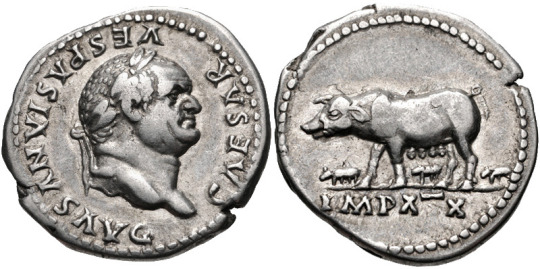
Vespasian denarius, struck 77-78.
Obverse depicts Vespasian facing right.
Reverse depicts a sow with three little piglets.

Vespasian sestertius, struck 71.
Obverse shows a very realistic portrait of Vespasian.
Reverse depicts the goddess Roma, seated on the 7 hills, Romulus and Remus with the wolf are seen to the bottom left of her, the personification of the Tiber to the right of her feet.
#ancient coins#ancient rome#ancient art#ancient history#roman art#roman history#history#classical art#art
3 notes
·
View notes
Text
Earthquakes in Various Places, Swiftie Stuff, The Oasis of Human DNA, Fighting Antisemitism with the Truth, Exposing Thousands of Years of European Genocide and Ethnic Cleansing Against Israelis and Hebrews, Reminding True Followers of Jesus Christ about the Truths of Jesus Christ during Roman Invasion/Occupation, and Fighting the Lies of the Antisemitic Antichrist Sunday "Lord's Day" with Scriptural Truths. Part 4/5.
This is all from Wikipedia as well to highlight that Jesus Christ wasn't being antisemitic or a traitor, he was being a freedom fighter for all native Israelis and Hebrews against actual Roman-loyalist traitors:
In Jerusalem, Herod introduced foreign forms of entertainment, and erected a golden eagle at the entrance of the Temple, which suggested a greater interest in the welfare of Rome than of Jews.
Herod's taxes garnered a bad reputation: his constant concern for his reputation led him to make frequent, expensive gifts,
increasingly emptying the kingdom's coffers, and such lavish spending upset his Jewish subjects.
The two major Jewish sects of the day, the Pharisees and the Sadducees, both showed opposition to Herod. The Pharisees were discontented because Herod disregarded many of their demands with respect to the Temple's construction.
The Sadducees, who were closely associated with priestly responsibilities in the Temple, opposed Herod because he replaced their high priests with outsiders from Babylonia and Alexandria, in an effort to gain support from the Jewish Diaspora.
Herod's outreach efforts gained him little, and at the end of his reign anger and dissatisfaction were common amongst Jews. Heavy outbreaks of violence and riots followed Herod's death in many cities, including Jerusalem, as pent-up resentments boiled over.
The scope of the disturbances sparked hopes that the Jews of Judea might someday overthrow the Roman overlords, hopes reawakened decades later in the outbreak of the First Jewish-Roman War in 66 CE.
Jewish and Christian messianism
Most of Jesus's teachings were intelligible and acceptable in terms of Second Temple Judaism; what set Christians apart from Jews was their faith in Christ as the resurrected messiah.
While Christianity acknowledges only one ultimate Messiah, Judaism can be said to hold to a concept of multiple messiahs. The two most relevant are the Messiah ben Joseph and the traditional Messiah ben David. Some scholars have argued that the idea of two messiahs, one suffering and the second fulfilling the traditional messianic role,
was normative to ancient Judaism, predating Jesus. Jesus would have been viewed by many as one or both.
Jewish messianism has its root in the apocalyptic literature of the 2nd century BCE to the 1st century CE, promising a future "anointed" leader or Messiah to resurrect the Israelite "Kingdom of God", in place of the foreign rulers of the time. According to Shaye J.D. Cohen, Jesus's failure to establish an independent Israel, and his death at the hands of the Romans, caused many Jews to reject him as the Messiah. Jews at that time were expecting a military leader as a Messiah, such as Bar Kokhba.
In 66 CE the Jewish population rebelled against the Roman Empire. Four years later, on 4 August 70 CE (the 9th day of Av and possibly the day on which Tisha B'Av was observed) or 30 August 70 CE, Roman legions under Titus retook and destroyed much of Jerusalem and the Second Temple. The Arch of Titus, which was built in Rome to commemorate Titus's victory in Judea, depicts a Roman victory procession with soldiers carrying spoils from the Temple, including the Menorah.
Titus and his soldiers celebrated victory upon their return to Rome by parading the Menorah and Table of the Bread of God's Presence through the streets. Up until this parading, these items had only ever been seen by the High Priest of the Temple. This event was memorialized in the Arch of Titus. According to an inscription on the Colosseum, Emperor Vespasian built the Colosseum with war spoils in 79 CE – possibly from the spoils of the Second Temple.
The sects of Judaism that had their base in the Temple dwindled in importance, including the priesthood and the Sadducees.
The Temple was on the site of what today is the Dome of the Rock. The gates led out close to Al-Aqsa Mosque (which came much later).
Although Jews continued to inhabit the destroyed city, Emperor Hadrian established a new city called Aelia Capitolina.
At the end of the Bar Kokhba revolt in 135 CE, many of the Jewish communities were massacred and Jews were banned from living inside Jerusalem.
A pagan Roman temple was set up on the former site of Herod's Temple.
Historical accounts relate that not only the Jewish Temple was destroyed, but also the entire Lower city of Jerusalem.
Even so, according to Josephus, Titus did not totally raze the towers (such as the Tower of Phasael, now erroneously called the Tower of David), keeping them as a memorial of the city's strength. The Midrash Rabba (Eikha Rabba 1:32) recounts a similar episode related to the destruction of the city, according to which Rabban Yohanan ben Zakkai, during the Roman siege of Jerusalem, requested of Vespasian that he spare the westernmost gates of the
city (Hebrew: פילי מערבאה) that lead to Lydda (Lod). When the city was eventually taken, the Arab auxiliaries who had fought alongside the Romans under their general, Fanjar, also spared that westernmost wall from destruction.
Jewish eschatology includes a belief that the Second Temple will be replaced by a future Third Temple in Jerusalem.
The Galilee earthquake of 363 was a pair of severe earthquakes that shook the Galilee and nearby regions on May 18 and 19.
The maximum perceived intensity for the events was estimated to be VII (Very strong) on the Medvedev–Sponheuer–Karnik scale.
The earthquakes occurred on the portion of the Dead Sea Transform (DST) fault system between the Dead Sea and the Gulf of Aqaba.
Impact:
Sepphoris, north-northwest of Nazareth, was severely damaged. Nabratein and the Nabratein synagogue (northeast of Safed) were destroyed.
The earthquake may have been responsible for the failure of the plan to rebuild the Temple in Jerusalem with the permission of the Emperor Julian.
Petra, in what is now Jordan, was fatally damaged.
Lag BaOmer (Hebrew: לַ״ג בָּעוֹמֶר, LaG Bāʿōmer), also Lag B'Omer or Lag LaOmer, is a Jewish religious holiday celebrated on the 33rd day of the Counting of the Omer, which occurs on the 18th day of the Hebrew month of Iyar. In modern-day Israel, the holiday also serves to commemorate the Bar Kokhba Revolt against the Romans
and is "a symbol for the fighting Jewish spirit". The Palmach division of the Haganah was established on Lag BaOmer 1941, and the government order creating the Israel Defense Forces was issued on Lag BaOmer 1948. Beginning in 2004, the Israeli government designated Lag BaOmer as the day for saluting the IDF reserves. (Wikipedia)
The Bar Kokhba revolt, also known as the Third Jewish Revolt or the 'Jewish Expedition' as the Romans named it, was a rebellion by the Jews of the Roman province of Judea, led by Simon bar Kokhba, against the Roman Empire. The last of the three Jewish���Roman wars, it was fought c. 132–136 CE.
The revolt erupted as a result of religious and political tensions in Judea following on the failed First Revolt in 66–73 CE, including the establishment of a large Roman military presence in the province, changes in administrative and economic life, and the failure of revolts in the diaspora. The immediate reasons seem to be the construction of a new city, Aelia Capitolina, over the ruins of Jerusalem and the erection of a temple to Jupiter on the Temple Mount.
The Bar Kokhba revolt greatly influenced the course of Jewish history, philosophy and religion. Despite easing the persecution of Jews following Hadrian's death in 138 CE, the Romans barred Jews from Jerusalem, except for attendance in Tisha B'Av. (Wikipedia)
The Bar Kokhba revolt was among the key events to differentiate Christianity as a religion distinct from Judaism. (Wikipedia)
Matthew 4:1
Then Jesus was led by the Spirit into the wilderness to be tempted by the devil.
Matthew 4:2
After fasting forty days and forty nights, he was hungry.
Matthew 4:3
During that time the devil came and said to him, “If you are the Son of God, tell these stones to become loaves of bread.”
Matthew 4:4
But Jesus told him, “No! The Scriptures say, ‘People do not live by bread alone, but by every word that comes from the mouth of God.’”
Matthew 4:5
Then the devil took him to the holy city, Jerusalem, to the highest point of the Temple,
Matthew 4:6
and said, “If you are the Son of God, jump off! For the Scriptures say, ‘He will order his angels to protect you. And they will hold you up with their hands so you won’t even hurt your foot on a stone.’”
Matthew 4:7
Jesus responded, “The Scriptures also say, ‘You must not test the Lord your God.’”
Matthew 4:8
Next the devil took him to the peak of a very high mountain and showed him all the kingdoms of the world and their glory.
Matthew 4:9
“I will give it all to you,” he said, “if you will kneel down and worship me.”
Matthew 4:10
“Get out of here, Satan,” Jesus told him. “For the Scriptures say, ‘You must worship the Lord your God and serve only him.’”
Matthew 4:11
Then the devil went away, and angels came and took care of Jesus.
TANAKH (Jewish Publication Society, Hebrew-English): Pages 386 and 387:
Deuteronomy 5:1
Moses summoned all the Israelites and said to them: Hear, O Israel, the laws and rules that I proclaim to you this day! Study them and observe them faithfully!
Deuteronomy 5:2
The Lord our God made a covenant with us at Horeb.
Deuteronomy 5:3
It was not with our fathers that the Lord made this covenant, but with us, the living, every one of us who is here today.
Deuteronomy 5:4
Face to face the Lord spoke to you on the mountain out of the fire--
Deuteronomy 5:5
I stood between the Lord and you at that time to convey the Lord's words to you, for you were afraid of the fire and did not go up the mountain--saying:
Deuteronomy 5:6
I the Lord am your God who brought you out of the land of Egypt, the house of bondage:
Deuteronomy 5:7
You shall have no other gods beside Me.
Deuteronomy 5:8
You shall not make for yourself a sculptured image, any likeness of what is in the heavens above, or on the earth below, or in the waters below the earth.
Deuteronomy 5:9
You shall not bow down to them or serve them. For I the Lord your God am an impassioned God, visiting the guilt of the parents upon the children, upon the third and upon the fourth generations of those who reject Me,
Deuteronomy 5:10
but showing kindness to the thousandth generation of those who love Me and keep My commandments.
Deuteronomy 5:11
You shall not swear falsely by the name of the Lord your God; for the Lord will not clear on who swears falsely by His name.
Deuteronomy 5:12
Observe the sabbath day and keep it holy, as the lord your God has commanded you.
Deuteronomy 5:13
Six days you shall labor and do all your work,
Deuteronomy 5:14
but the seventh day is a sabbath of the Lord your God; you shall not do any work--you, your son or your daughter, your male or female slave, your ox or your ass, or any of your cattle, or the stranger in your settlements, so that your male and female slave may rest as you do.
Deuteronomy 5:15
Remember that you were a slave in the land of Egypt and the Lord your God freed you from there with a mighty hand and an outstretched arm; therefore the Lord your God has commanded you to observe the sabbath day.
Deuteronomy 5:16
Honor your father and your mother, as the Lord your God has commanded you, that you may long endure, and that you may fare well, in the land that the Lord your God is assigning to you.
Deuteronomy 5:17
You shall not murder. You shall not commit adultery. You shall not steal. You shall not bear false witness against your neighbor.
Deuteronomy 5:18
You shall not covet your neighbor's wife. You shall not crave your neighbor's house, or his field, or his male or female slave, or his ox, or his ass, or anything that is your neighbor's.
Deuteronomy 5:19
The Lord spoke those words--those and no more--to your whole congregation at the mountain, with a mighty voice out of the fire and the dense clouds. He inscribed them on two tablets of stone, which He gave to me.
Deuteronomy 5:20
When you heard the voice out of the darkness, while the mountain was ablaze with fire, you came up to me, all your tribal heads and elders,
Deuteronomy 5:21
and said, "The Lord our God has just shown us His majestic Presence, and we have heard His voice out of the fire; we have seen this day that man may live though God has spoken to him.
#august#hope#holy bible#tanakh#christianity#judaism#christian faith#jesus christ#earthquake#israel#jewish#history#world history#antisemitism#genocide#ethnic cleansing#war crimes#crimes against humanity#bible scripture#bible study
3 notes
·
View notes
Photo

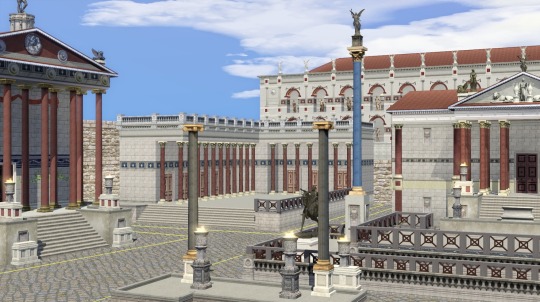

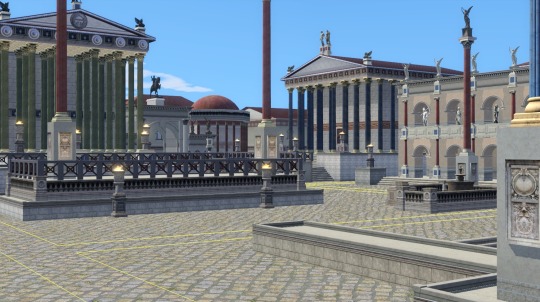
The forum is coming along nicely. I finally added my second version of the tabularium and made subtle adjustments to the hilltop behind the Temple of Concordia. Meanwhile, I added another structure to the mix, the Porticus Deorum Consentium, which in most images of the forum you seen in paintings was replaced/overshadowed by the Temple of Vespasian and Titus.
While I’m not completely committed to it as of late, I have opted to sculpt most of the terrain for Latium in the interim instead of building from a map
17 notes
·
View notes